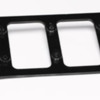I'm considering what I need to do to build a competitive engine for vintage racing. The leaders were running down the big straits in that rpm catagory. The issue is that probably no matter what I build it won't have a very long life expectancy.
The Pantera actually has an advantage with the ZF in the gearing with 5th being a .7 od. That is presuming I can make it pull with power at that rpm.
Probably an engine that would survive to 7500 would be adequate. With the documented reputation of the stock 351c block developing cracks through the webbing at high rpm use, I am just considering my alternatives.
Probably the thing to do would be to use the Ford Motorsport 351w racing block. The prospect of titanium connecting rods and the like have me cautious at declaring any sort of serious intent.
My opinion frankly is that I am building a WINSTON CUP or NASCAR 351c to run with them and I don't know if I want to try. Been there done that but the drums seem to be calling again. I hate when that happens.

When I built my engine I never seriously considered having to survive at those rpms. I'm probably safe buzzing to 7200 now.
I'm just here picking brains for crumbs.
I need to consider at this point if I can compete with 650hp 289's, etc, or even want to.
I just never heard anyone discuss the useage of a main girdle on a C before.
The best engines come apart regularly at the big rpms. See. I'm answering my own questions already.




